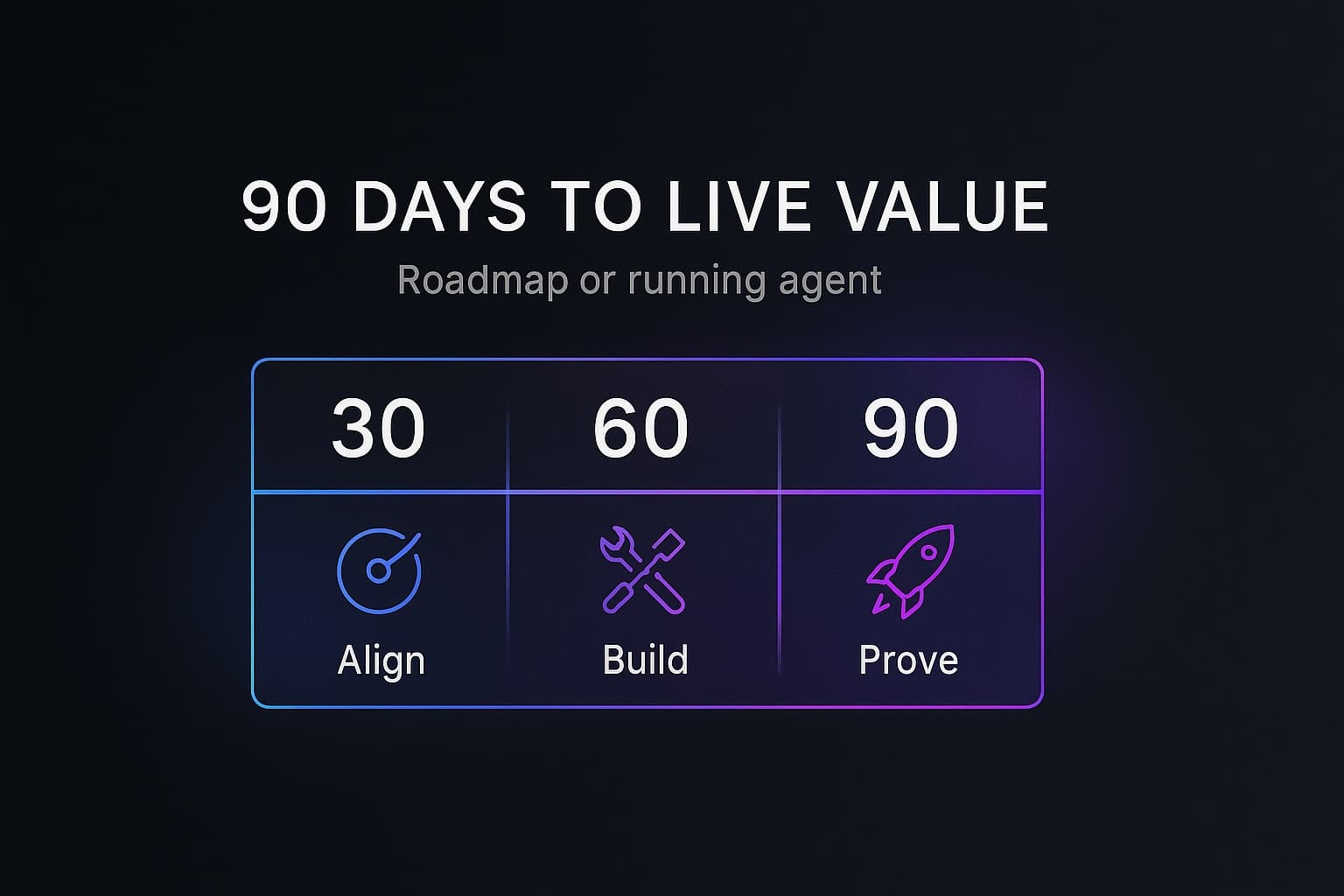Fast. Then faster. If you give any initiative twelve months, it will take twelve months. If you give it ninety days, it forces clarity. At Lab17, “90 days to live value” means that in three months you either have a running workflow or agent in your stack, or you leave with a validated blueprint your team can execute. Often, you get both: a thin slice shipped to production and a plan to scale what worked.
Why ninety days? It’s long enough to align leadership, integrate with real systems, and see measurable impact—yet short enough to avoid analysis paralysis. It creates a simple rhythm: decide, build, prove, then scale.
Live value has a precise definition. First, people actually use the thing in their day‑to‑day work. Second, usage and outcomes are visible on a small dashboard. Third, we can explain the impact with one metric everyone recognizes—time saved, error reduction, response time, pipeline quality, or SLA hit‑rate.
Below is the 30/60/90 playbook we run with startups and enterprises. Adjust the specifics to your context; keep the cadence.
30 days — align and choose one thin slice
Start by aligning leadership on goals and guardrails. What are we trying to improve—support response time, sales qualification, internal research speed? What are the constraints—security, privacy, compliance, brand risk? Who owns decisions on your side? Clear ownership is non‑negotiable.
Map 5–10 candidate use cases. Rank them by value, effort, and risk. Kill options with fuzzy metrics or hard dependencies you can’t unlock. Pick a thin slice where a small, visible win is possible—intake triage, first‑draft brief generation, L2 support suggestions, or enrichment for outbound lists.
Do the plumbing only for that slice: minimum access, minimum data, minimum tools. Authenticate, connect to the one system you need (CRM/helpdesk/DB/docs), and set up a simple event stream so you can measure usage from day one.
Expected outcomes by Day 30: a 90‑day plan with a single success metric; a prioritized backlog with owners; access granted to the minimum systems; and a one‑page Definition of Done for Day 90.
Days 31–60 — build and integrate
Design, build, and integrate the agent. Keep the architecture boring and the surface area small. If retrieval is needed, scope the corpus and version it. If tools are needed, prefer one or two well‑tested connectors over a toolbox of half‑wired APIs. Add guardrails early: least‑privilege access, input/output logging, rate limits, and PII handling rules.
Dogfood with real users. Put a weekly demo on the calendar. Capture friction in a shared channel. Most speed comes from cutting approval loops from weeks to days. Instrument metrics as you go: events per user, latency, success rate, and human handoff rate.
By Day 60 the agent or workflow should be feature‑complete behind a small flag or targeted route. You should also have basic monitoring, a simple dashboard, and a runbook that describes fallbacks and when to hand off to a human.
Days 61–90 — launch and prove
Roll out to a small pilot group. Expect back‑and‑forth in the first week; keep the iteration loop tight. The goal isn’t perfection—it’s a reliable path to value. Compare your metric against baseline: did we cut time per task, increase first‑touch quality, or reduce back‑and‑forth?
We judge success by one number and two signals. The number is the success metric you chose on Day 1. The signals are adoption (“are people using it without being pushed?”) and sentiment (“would they miss it if it disappeared?”).
Close the 90 days with a handover. That includes docs, a recorded run‑through, a playbook for the pattern we used, and a “next steps” plan to scale—more users, more workflows, or deeper integration.
Roadmap‑first vs agent‑first
There are two valid paths. If direction is unclear or stakeholders are many, go roadmap‑first: align, de‑risk, and socialize before building. If the problem is clear and pain is acute, go agent‑first: ship a thin slice quickly, then generalize. Many teams start roadmap‑first and switch to agent‑first once people can click on something that works.
Minimal governance that keeps speed
Governance should protect speed, not kill it. Keep secrets in a vault and rotate regularly. Define what the agent can read and write; log access. Add error handling and a safe fallback. Put new capabilities behind a small feature flag and write a one‑line rollback plan. Keep approvals light but explicit—who must say yes, and by when?
Metrics that matter
Track adoption (weekly active users, sessions per user), speed (task time vs baseline; latency at P50/P95), quality (task success, human handoff rate, error rate), and business impact (time saved, SLA hit‑rate, conversion where relevant). Don’t drown in dashboards; pick one lead metric and review it weekly with the team.
Common pitfalls and how to avoid them
(1) Starting too big—trying to automate an end‑to‑end process on the first attempt. Cut to a thin slice. (2) Tool sprawl—wiring five LLM providers and three vector stores before shipping anything. Pick one stack your team can operate. (3) No owner—if no one can grant access or say “ship it,” speed dies. Appoint an internal owner. (4) Missing evaluation—subjective vibes aren’t enough. Put simple checks in place: task success on sampled cases, drift alerts for prompts/data, and human spot‑reviews.
(5) Ignoring change management—agents change habits. Plan for onboarding, short videos, and an internal champion. (6) Forgetting fallbacks—decide when to hand off to a human and make it one click. (7) Skipping instrumentation—if you can’t see usage and outcome, you can’t improve.
What we need from you
One internal owner, a small pilot group of real users, access to the minimum systems, and a shared channel for feedback. With those in place, ninety days is plenty.
After 90 days: scale what works
Turn the pattern into a template. Automate evaluation—spot checks, drift detection, version tracking. Expand carefully: add more users or a second workflow, not both at once. Move ownership fully in‑house so your team can run faster without us.
Fast. Then faster. Ninety days to live value—roadmap or running agent. Then scale what works.
